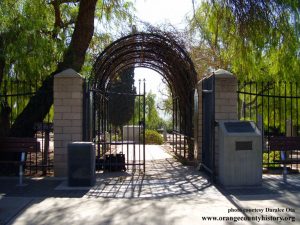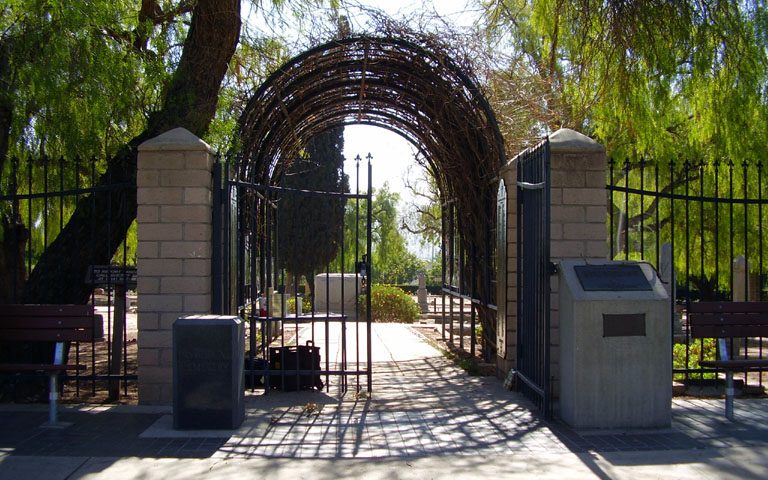Alfonso Yorba
Santa Ana Journal, November 23, 1935
“I order and direct that there be paid by my estate all remaining expenses necessary for the completion of the edifice destined to be a chapel which has been built on the land of my Rancho Cañada de Santa Ana or San Antonio.”
So directed the dying Don Bernardo Yorba in his last will and testament, November 14, 1858.
Today the broken adobe walls of two small rooms, abandoned, roofless, and exposed to the ravages of rainstorms and treasure-seekers, stand beside the substantial and uninspiring walls of a modern wooden chapel at Yorba [now part of Yorba Linda].
Once these formed the sacristy and padre’s room of the picturesque long adobe chapel of San Antonio, finished by the Yorba heirs in obedience to their father’s will.
Doña Felipa Yorba de Dominguez, one of Don Bernardo’s granddaughters, born in 1852 and still living in the vicinity on ancestral lands, remembers quite well the completion of the adobe church.
“It was a long building, with the sacristy and padre’s rooms in back of the altar,” she said. “On the south side of the edifice, near the sacristy, was another room, or wing, in which lived a family who took care of the property.”
Doña Felipa pointed out that the present white wood chapel is built over the razed ruins of the long nave of the adobe church. “It was a pity,” continued Señora de Dominguez, “that they did not repair the long adobe room instead of building the wooden one. The church was a fine building for its day. It had a good roof of ‘tejamanil’ and a wood floor. The windows, however, were few and quite small, with iron rejas. In front, about where the modern church entrance is, was a large corridor. Whenever the padre came for a wedding or church fiesta the corridor was gaily decorated with paper streamers, flowers and ribbons.
“Ay, those fiestas,” she exclaimed, her eyes lighting up with happy memories of the 1860s. “Then was when your family, our cousins of San Juan Capistrano and Santa Ana Abajo, would come up with their vaqueros to compete with us in the corridas. I remember your ‘tio,’ Ramon Yorba, and how he rode with the best of them in spite of being a cripple with only one leg.”
Those were the days of bullfights, races, picnics and fandangos. Following the aged doña’s thoughts, one sees the host of dons and doñas in all the multicolored splendor of wealthy rancheros as they enter the bedecked and whitewashed chapel to attend their relatives’ weddings or other services at the rancho church.
“They made us sit on the floor around the edges of the room,” continued the dignified señora, “while the adults occupied the benches. There were plenty of adult Yorbas in those days, Don Bernardo alone being the father of 21 children, of which 11 were boys.
“Little wonder the dying Don Bernardo was perturbed over the inability of his mansion chapel to accommodate even his own family, let along a host of relatives and hundreds of Indian retainers.

Courtesy Daralee Ota
“From my father’s adobe on the hill I watched the funeral procession set off for Los Angeles,” Doña Felipa said, “and the hundreds of Indians rent the air with their cries of sorrow. The indios abandoned the hacienda en masse once their beloved señor was laid away and never again were seen to till the fields and tend the herds of his old Rancho San Antonio, nor did they ever pass through the portals of the adobe chapel he had prepared for them.”
The 1899 “pardon” or census of the Yorba parish reveals 265 “parrequianos,” or parishioners, mostly Yorbas, Peraltas and other Spanish and Mexican Californians. Capt. Don Juan de la Guerra was president of the parish committee. But as the parish flourishes, the adobe ruins melt down into the earth from which they came. Now only one wall is intact, reaching a height of about 15 feet at the gable and forming part of the 16 by 22 foot sacristy, while the remaining room is 13 x 22 feet in size.
Like sentinels guarding the fallen “capilla” from their hilltop heights, the ruined Prudencio Yorba and Anastacio Botiller adobes lift their gaunt ruins toward the skies. Even the closed “campo santo,” or hilltop cemetery, is desolate and forbidding and seems to mourn the neglect and oblivion of Don Bernardo Yorba’s adobe chapel of San Antonio.
[The Yorba Cemetery has been preserved as a county historical site, but all of the adobes and even the wooden chapel are now long gone.]

